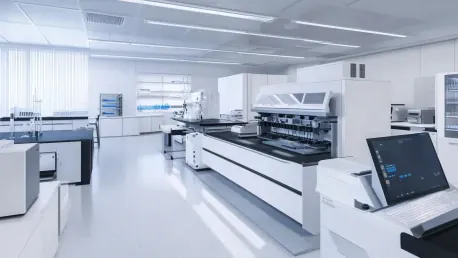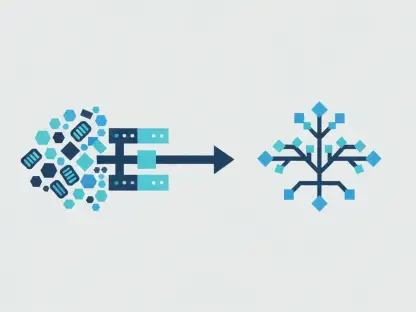The lab automation market is undergoing a significant transformation, driven by technological advancements, increasing precision demands, and the need for efficiency in laboratory operations. Lab automation involves using automated equipment and systems to execute laboratory tasks such as sample preparation, testing, and data analysis. This automation reduces manual labor, boosts throughput, and enhances accuracy. In the rapidly evolving landscape of laboratory sciences, automation is not just about substituting manual tasks but transforming entire methodologies. As labs become more reliant on data-driven insights, the capacity to process and analyze vast amounts of information swiftly and accurately is paramount. Automation stands at the crossroads of this need, ensuring that labs worldwide can meet rising demands without compromising the quality of their results.
Technological Advancements Driving Lab Automation
Technological innovations are at the forefront of the lab automation revolution, with numerous trends shaking up traditional practices. The integration of artificial intelligence (AI), machine learning (ML), and big data analytics is transforming laboratory operations considerably. AI and ML can analyze large datasets, detect patterns, and provide predictive insights, enhancing laboratory efficiency and decision-making. Additionally, the advent of the Internet of Things (IoT) enables real-time monitoring and remote management, optimizing workflows and minimizing the need for manual intervention.
Miniaturization represents another key trend, as smaller devices now allow high-throughput screening in more reduced volumes, effectively slashing costs while improving sample throughput and time efficiency. The integration of cloud technology also plays a critical role. With cloud capabilities, data storage, sharing, and analysis become substantially more manageable, promoting improved collaboration, real-time access to results, and rapid, data-driven decision-making. These advancements fundamentally re-shape the ways in which labs operate, driving unprecedented levels of productivity and accuracy.
Product Types Revolutionizing Lab Automation
A broad spectrum of products is transforming the lab automation landscape, each designed to execute specific laboratory functions with elevated precision. For example, liquid handling systems automate repetitive tasks like pipetting, reagent dispensing, and sample dilution, significantly enhancing both speed and accuracy. Automated analyzers, prevalent in diagnostic labs, carry out a range of chemical, biological, and immunological assays with minimal human intervention, thereby increasing reliability and efficiency.
Robotic systems also play a pivotal role, facilitating high-throughput screening, sample transport, and laboratory inventory management by automating complex processes. Microplate readers, another crucial addition, automate the analysis of microplates utilized in biological research, assays, and screening applications. Software solutions serve as the backbone of this ecosystem, integrating various instruments and data management systems to streamline workflows and allow for remote control and monitoring of lab procedures. To manage vast volumes of biological samples, storage, and retrieval systems ensure proper cataloging and significantly reduce human error. Collectively, these innovations position labs to achieve higher throughput, reduced errors, and faster results, fundamentally altering operational dynamics.
Key Market Trends Shaping the Future
Several key trends are emerging in the lab automation market, poised to shape its future trajectory over the next decade. The integration of AI, ML, and big data analytics remains a significant trend, boosting the efficiency and decision-making capabilities within laboratories. Real-time monitoring and remote management through IoT are also gaining traction, optimizing workflows and minimizing the need for manual intervention, thereby ensuring smooth, uninterrupted operations.
Miniaturized devices have also gained significant momentum, dramatically enhancing sample throughput and cost efficiency by allowing high-throughput screening in smaller volumes. Cloud integration and sophisticated data management systems are increasingly facilitating data storage, sharing, and analysis, fostering improved collaboration and faster, data-driven decisions. The rise of big data drives an ever-growing need for advanced data management strategies, with AI-powered analytics offering invaluable insights to optimize experimental design and interpretation of results. These trends, converging at the intersection of technological innovation and operational necessity, redefine how laboratories function in a rapidly changing scientific landscape.
Sustainability and Eco-friendly Solutions
Sustainability is emerging as a key concern in laboratory automation, with a growing emphasis on developing energy-efficient and eco-friendly automation solutions. Manufacturers are focusing on designing systems that reduce the consumption of harmful chemicals and minimize environmental impact, translating to substantial operational cost savings over time. The trend toward eco-friendly lab practices is further reinforced by regulatory changes that promote sustainability in laboratories.
Lab devices are now being engineered to cut waste and lower carbon footprints, with energy-efficient technologies becoming paramount in reducing both operational expenditure and environmental damage. This focus on sustainability not only benefits the environment but also enhances the efficiency and cost-effectiveness of lab operations. As regulatory frameworks continue to evolve, eco-friendly solutions will likely become a standard requirement, pushing manufacturers to innovate continuously and develop greener, more sustainable lab automation technologies.
Increased Adoption in Diagnostics and Clinical Labs
The COVID-19 pandemic underscored the critical role of automation in diagnostics, particularly for high-throughput testing methods like PCR and antibody testing. Automation in diagnostics ensures faster processing times, enhanced accuracy, and scalability, which are crucial in managing large volumes of tests in critical situations. Post-pandemic, automation continues to gain traction, particularly in point-of-care testing (POCT), enabling rapid diagnostics, reduced patient wait times, and lowered healthcare costs.
Automation is becoming indispensable in clinical labs, driving advancements in high-throughput disease detection and monitoring. Automated systems guarantee faster and more accurate test results, significantly improving patient outcomes while reducing overall healthcare expenses. The ongoing shift towards automation in diagnostics and clinical labs reflects a broader trend aimed at maximizing efficiency and accuracy in medical testing, ultimately leading to better and more accessible healthcare solutions.
Competitive Landscape and Key Players
The competitive landscape of the lab automation market features major players leading the charge in innovation, collaboration, and market expansion. Companies such as Thermo Fisher Scientific, Abbott Laboratories, Beckman Coulter (Danaher Corporation), Siemens Healthineers, and Agilent Technologies are at the forefront of this transformative shift. These firms invest heavily in research and development to advance their product offerings and expand their market presence substantially.
Thermo Fisher Scientific, for instance, offers an extensive range of automated laboratory equipment, including liquid handling systems and automated analyzers. Meanwhile, Abbott Laboratories is renowned for its high-performance diagnostic and lab automation systems, especially in clinical testing environments. Beckman Coulter delivers advanced automation solutions for laboratory instrumentation, with particular strengths in clinical chemistry, immunoassays, and hematology. Siemens Healthineers and Agilent Technologies are also prominent players, offering a wide array of products from laboratory analyzers to cutting-edge software solutions optimized for various scientific research fields. These companies’ investments and strategic collaborations with research institutions, healthcare providers, and tech companies are driving innovation and competitive dynamics in the lab automation market.
Market Segmentation and Applications
The lab automation market is segmented by application, end-user, and region. By application, it spans pharmaceutical and biotechnology, clinical diagnostics, food and beverage testing, and environmental testing. In the pharmaceutical and biotechnology sectors, automation significantly streamlines drug discovery, development, and testing processes, enhancing both speed and accuracy.
In clinical diagnostics, the role of lab automation is critical, enabling high-throughput disease detection and monitoring, which ensures faster, more accurate test results. In the food and beverage industry, lab automation ensures stringent quality control and compliance with regulatory standards. Environmental testing benefits from automation by facilitating the monitoring of air, water, and soil quality for regulatory compliance. These diverse applications underscore the versatility and widespread utility of lab automation across different sectors, driving efficiency, accuracy, and compliance in various scientific and industrial processes.
Conclusion and Future Outlook
The lab automation market stands on the cusp of sustained growth, driven by continuous technological advancements and the ever-increasing demand for high-throughput testing. Future trends will likely center around further integration of AI, miniaturization, and sustainability. As technology continues to advance, lab automation systems will become more accessible, improving efficiency, reducing costs, and enhancing data accuracy across a wide array of industries. The market is expected to expand significantly, with the Asia-Pacific region showcasing the fastest growth due to rising healthcare infrastructure improvements and increasing research initiatives.
Advanced technologies and sustainable practices will define the future trajectory of lab automation, offering vast growth opportunities. The continued adoption of automation in clinical diagnostics, research, and environmental testing will likely propel the market towards new heights, revolutionizing laboratory operations and enabling a new era of scientific discovery and innovation.









